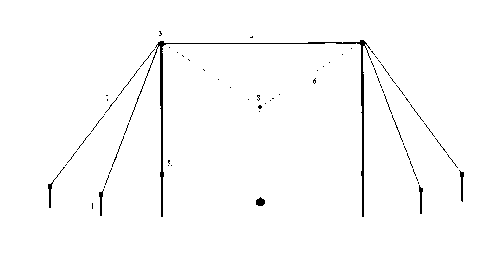Some of the information on this Web page has been provided by external sources. The Government of Canada is not responsible for the accuracy, reliability or currency of the information supplied by external sources. Users wishing to rely upon this information should consult directly with the source of the information. Content provided by external sources is not subject to official languages, privacy and accessibility requirements.
Any discrepancies in the text and image of the Claims and Abstract are due to differing posting times. Text of the Claims and Abstract are posted:
| (12) Patent Application: | (11) CA 2917496 |
|---|---|
| (54) English Title: | MULTIPLE SPORT TRAINING DEVICE |
| (54) French Title: | APPAREIL D'ENTRAINEMENT MULTI SPORT |
| Status: | Deemed Abandoned and Beyond the Period of Reinstatement - Pending Response to Notice of Disregarded Communication |
| (51) International Patent Classification (IPC): |
|
|---|---|
| (72) Inventors : |
|
| (73) Owners : |
|
| (71) Applicants : |
|
| (74) Agent: | |
| (74) Associate agent: | |
| (45) Issued: | |
| (22) Filed Date: | 2016-01-13 |
| (41) Open to Public Inspection: | 2017-07-13 |
| Availability of licence: | N/A |
| Dedicated to the Public: | N/A |
| (25) Language of filing: | English |
| Patent Cooperation Treaty (PCT): | No |
|---|
| (30) Application Priority Data: | None |
|---|
A one player sports training apparatus which allows for the user to play
multiple sports alone. The
game is played between two telescoping poles and utilizes an elastic return
system of which a ball is
attached. Each pole has a bearing assembly on top that makes it stable and
does not allow the game
to tangle. The user hits the ball and has the ball return close to the
original position because of the
elastics stretching and retracting which creates velocity. The balls used are
tennis ball, soccerball,
football, hockey puck, Frisbee, golf ball, and rugby ball.
Note: Claims are shown in the official language in which they were submitted.
Note: Descriptions are shown in the official language in which they were submitted.

2024-08-01:As part of the Next Generation Patents (NGP) transition, the Canadian Patents Database (CPD) now contains a more detailed Event History, which replicates the Event Log of our new back-office solution.
Please note that "Inactive:" events refers to events no longer in use in our new back-office solution.
For a clearer understanding of the status of the application/patent presented on this page, the site Disclaimer , as well as the definitions for Patent , Event History , Maintenance Fee and Payment History should be consulted.
| Description | Date |
|---|---|
| Letter Sent | 2023-08-21 |
| Refund Request Received | 2023-03-29 |
| Inactive: Office letter | 2022-07-05 |
| Inactive: Reply received: MF + late fee | 2022-06-01 |
| Inactive: Dead - RFE never made | 2022-04-06 |
| Application Not Reinstated by Deadline | 2022-04-06 |
| Letter Sent | 2022-01-13 |
| Deemed Abandoned - Failure to Respond to Maintenance Fee Notice | 2021-07-13 |
| Inactive: Office letter | 2021-05-03 |
| Inactive: Reply received: MF + late fee | 2021-04-12 |
| Deemed Abandoned - Failure to Respond to a Request for Examination Notice | 2021-04-06 |
| Letter Sent | 2021-01-13 |
| Letter Sent | 2021-01-13 |
| Maintenance Request Received | 2019-12-05 |
| Common Representative Appointed | 2019-10-30 |
| Common Representative Appointed | 2019-10-30 |
| Maintenance Request Received | 2019-01-14 |
| Maintenance Request Received | 2018-01-08 |
| Application Published (Open to Public Inspection) | 2017-07-13 |
| Inactive: Cover page published | 2017-07-12 |
| Inactive: IPC assigned | 2016-04-29 |
| Inactive: IPC assigned | 2016-04-29 |
| Inactive: First IPC assigned | 2016-04-29 |
| Inactive: IPC assigned | 2016-04-29 |
| Inactive: IPC assigned | 2016-04-29 |
| Filing Requirements Determined Compliant | 2016-01-20 |
| Inactive: Filing certificate - No RFE (bilingual) | 2016-01-20 |
| Application Received - Regular National | 2016-01-15 |
| Small Entity Declaration Determined Compliant | 2016-01-13 |
| Abandonment Date | Reason | Reinstatement Date |
|---|---|---|
| 2021-07-13 | ||
| 2021-04-06 |
The last payment was received on 2019-12-05
Note : If the full payment has not been received on or before the date indicated, a further fee may be required which may be one of the following
Please refer to the CIPO Patent Fees web page to see all current fee amounts.
| Fee Type | Anniversary Year | Due Date | Paid Date |
|---|---|---|---|
| Application fee - small | 2016-01-13 | ||
| MF (application, 2nd anniv.) - small | 02 | 2018-01-15 | 2018-01-08 |
| MF (application, 3rd anniv.) - small | 03 | 2019-01-14 | 2019-01-14 |
| MF (application, 4th anniv.) - small | 04 | 2020-01-13 | 2019-12-05 |
| 2021-04-12 | 2021-04-12 |
Note: Records showing the ownership history in alphabetical order.
| Current Owners on Record |
|---|
| ERME ERIC EDWARD |
| Past Owners on Record |
|---|
| None |